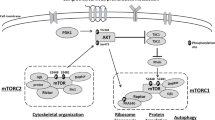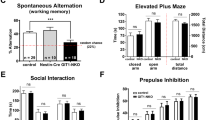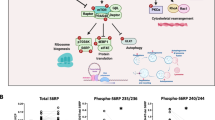Abstract
Numerous investigations support decreased glutamatergic signaling as a pathogenic mechanism of schizophrenia, yet the molecular underpinnings for such dysregulation are largely unknown. In the post-mortem dorsolateral prefrontal cortex (DLPFC), we found striking decreases in tyrosine phosphorylation of N-methyl-D aspartate (NMDA) receptor subunit 2 (GluN2) that is critical for neuroplasticity. The decreased GluN2 activity in schizophrenia may not be because of downregulation of NMDA receptors as MK-801 binding and NMDA receptor complexes in postsynaptic density (PSD) were in fact increased in schizophrenia cases. At the postreceptor level, however, we found striking reductions in the protein kinase C, Pyk 2 and Src kinase activity that in tandem can decrease GluN2 activation. Given that Src serves as a hub of various signaling mechanisms affecting GluN2 phosphorylation, we postulated that Src hypoactivity may result from convergent alterations of various schizophrenia susceptibility pathways and thus mediate their effects on NMDA receptor signaling. Indeed, the DLPFC of schizophrenia cases exhibit increased PSD-95 and erbB4 and decreased receptor-type tyrosine-protein phosphatase-α (RPTPα) and dysbindin-1, each of which reduces Src activity via protein interaction with Src. To test genomic underpinnings for Src hypoactivity, we examined genome-wide association study results, incorporating 13 394 cases and 34 676 controls. We found no significant association of individual variants of Src and its direct regulators with schizophrenia. However, a protein–protein interaction-based network centered on Src showed significant enrichment of gene-level associations with schizophrenia compared with other psychiatric illnesses. Our results together demonstrate striking decreases in NMDA receptor signaling at the postreceptor level and propose Src as a nodal point of convergent dysregulations affecting NMDA receptor pathway via protein–protein associations.
This is a preview of subscription content, access via your institution
Access options
Subscribe to this journal
Receive 12 print issues and online access
$259.00 per year
only $21.58 per issue
Buy this article
- Purchase on Springer Link
- Instant access to full article PDF
Prices may be subject to local taxes which are calculated during checkout





Similar content being viewed by others

References
Coyle JT . Glutamate and schizophrenia: beyond the dopamine hypothesis. Cell Mol Neurobiol 2006; 26: 365–384.
Javitt DC, Schoepp D, Kalivas PW, Volkow ND, Zarate C, Merchant K et al. Translating glutamate: from pathophysiology to treatment. Sci Transl Med 2011; 3: 102mr102.
Moghaddam B, Javitt D . From revolution to evolution: the glutamate hypothesis of schizophrenia and its implication for treatment. Neuropsychopharmacology 2012; 37: 4–15.
Farber NB . The NMDA receptor hypofunction model of psychosis. Ann NY Acad Sci 2003; 1003: 119–130.
Javitt DC, Zukin SR . Recent advances in the phencyclidine model of schizophrenia. Am J Psychiatry 1991; 148: 1301–1308.
Krystal JH, Karper LP, Seibyl JP, Freeman GK, Delaney R, Bremner JD et al. Subanesthetic effects of the noncompetitive NMDA antagonist, ketamine, in humans. Psychotomimetic, perceptual, cognitive, and neuroendocrine responses. Arch Gen Psychiatry 1994; 51: 199–214.
Moghaddam B, Krystal JH . Capturing the angel in ‘angel dust’: twenty years of translational neuroscience studies of NMDA receptor antagonists in animals and humans. Schizophr Bull 2012; 38: 942–949.
Mohn AR, Gainetdinov RR, Caron MG, Koller BH . Mice with reduced NMDA receptor expression display behaviors related to schizophrenia. Cell 1999; 98: 427–436.
Carty NC, Xu J, Kurup P, Brouillette J, Goebel-Goody SM, Austin DR et al. The tyrosine phosphatase STEP: implications in schizophrenia and the molecular mechanism underlying antipsychotic medications. Transl Psychiatry 2012; 2: e137.
Noetzel MJ, Jones CK, Conn PJ . Emerging approaches for treatment of schizophrenia: modulation of glutamatergic signaling. Discov Med 2012; 14: 335–343.
Erhardt S, Schwieler L, Nilsson L, Linderholm K, Engberg G . The kynurenic acid hypothesis of schizophrenia. Physiol Behav 2007; 92: 203–209.
Schwarcz R, Rassoulpour A, Wu HQ, Medoff D, Tamminga CA, Roberts RC . Increased cortical kynurenate content in schizophrenia. Biol Psychiatry 2001; 50: 521–530.
Poels EM, Kegeles LS, Kantrowitz JT, Slifstein M, Javitt DC, Lieberman JA et al. Imaging glutamate in schizophrenia: review of findings and implications for drug discovery. Mol Psychiatry 2014; 19: 20–29.
Akbarian S, Sucher NJ, Bradley D, Tafazzoli A, Trinh D, Hetrick WP et al. Selective alterations in gene expression for NMDA receptor subunits in prefrontal cortex of schizophrenics. J Neurosci 1996; 16: 19–30.
Kristiansen LV, Patel SA, Haroutunian V, Meador-Woodruff JH . Expression of the NR2B-NMDA receptor subunit and its Tbr-1/CINAP regulatory proteins in postmortem brain suggest altered receptor processing in schizophrenia. Synapse 2010; 64: 495–502.
Weickert CS, Fung SJ, Catts VS, Schofield PR, Allen KM, Moore LT et al. Molecular evidence of N-methyl-D-aspartate receptor hypofunction in schizophrenia. Mol Psychiatry 2013; 18: 1185–1192.
McBain CJ, Mayer ML . N-methyl-D-aspartic acid receptor structure and function. Physiol Rev 1994; 74: 723–760.
Salter MW . Cellular neuroplasticity mechanisms mediating pain persistence. J Orofac Pain 2004; 18: 318–324.
Coultrap SJ, Bayer KU . CaMKII regulation in information processing and storage. Trends Neurosci 2012; 35: 607–618.
Hsin H, Kim MJ, Wang CF, Sheng M . Proline-rich tyrosine kinase 2 regulates hippocampal long-term depression. J Neurosci 2010; 30: 11983–11993.
MacDonald JF, Kotecha SA, Lu WY, Jackson MF . Convergence of PKC-dependent kinase signal cascades on NMDA receptors. Curr Drug Targets 2001; 2: 299–312.
Salter MW, Kalia LV . Src kinases: a hub for NMDA receptor regulation. Nat Rev Neurosci 2004; 5: 317–328.
Husi H, Ward MA, Choudhary JS, Blackstock WP, Grant SG . Proteomic analysis of NMDA receptor-adhesion protein signaling complexes. Nat Neurosci 2000; 3: 661–669.
Kennedy MB . The postsynaptic density at glutamatergic synapses. Trends Neurosci 1997; 20: 264–268.
Tang TT, Yang F, Chen BS, Lu Y, Ji Y, Roche KW et al. Dysbindin regulates hippocampal LTP by controlling NMDA receptor surface expression. Proc Natl Acad Sci USA 2009; 106: 21395–21400.
Ma TM, Abazyan S, Abazyan B, Nomura J, Yang C, Seshadri S et al. Pathogenic disruption of DISC1-serine racemase binding elicits schizophrenia-like behavior via D-serine depletion. Mol Psychiatry 2013; 18: 557–567.
Law AJ, Kleinman JE, Weinberger DR, Weickert CS . Disease-associated intronic variants in the ErbB4 gene are related to altered ErbB4 splice-variant expression in the brain in schizophrenia. Hum Mol Genet 2007; 16: 129–141.
Hahn CG, Wang HY, Cho DS, Talbot K, Gur RE, Berrettini WH et al. Altered neuregulin 1-erbB4 signaling contributes to NMDA receptor hypofunction in schizophrenia. Nat Med 2006; 12: 824–828.
Agim ZS, Esendal M, Briollais L, Uyan O, Meschian M, Martinez LA et al. Discovery, validation and characterization of Erbb4 and Nrg1 haplotypes using data from three genome-wide association studies of schizophrenia. PLoS One 2013; 8: e53042.
Bjorge JD, Pang A, Fujita DJ . Identification of protein-tyrosine phosphatase 1B as the major tyrosine phosphatase activity capable of dephosphorylating and activating c-Src in several human breast cancer cell lines. J Biol Chem 2000; 275: 41439–41446.
Takahashi N, Nielsen KS, Aleksic B, Petersen S, Ikeda M, Kushima I et al. Loss of function studies in mice and genetic association link receptor protein tyrosine phosphatase alpha to schizophrenia. Biol Psychiatry 2011; 70: 626–635.
Fromer M, Pocklington AJ, Kavanagh DH, Williams HJ, Dwyer S, Gormley P et al. De novo mutations in schizophrenia implicate synaptic networks. Nature 2014; 506: 179–184.
Kirov G, Pocklington AJ, Holmans P, Ivanov D, Ikeda M, Ruderfer D et al. De novo CNV analysis implicates specific abnormalities of postsynaptic signalling complexes in the pathogenesis of schizophrenia. Mol Psychiatry 2012; 17: 142–153.
Kalia LV, Pitcher GM, Pelkey KA, Salter MW . PSD-95 is a negative regulator of the tyrosine kinase Src in the NMDA receptor complex. EMBO J 2006; 25: 4971–4982.
Pitcher GM, Kalia LV, Ng D, Goodfellow NM, Yee KT, Lambe EK et al. Schizophrenia susceptibility pathway neuregulin 1-ErbB4 suppresses Src upregulation of NMDA receptors. Nat Med 2011; 17: 470–478.
Hahn CG, Banerjee A, Macdonald ML, Cho DS, Kamins J, Nie Z et al. The post-synaptic density of human postmortem brain tissues: an experimental study paradigm for neuropsychiatric illnesses. PLoS One 2009; 4: e5251.
Glausier JR, Lewis DA . Dendritic spine pathology in schizophrenia. Neuroscience 2012; 251: 90–107.
Lewis DA . Neuroplasticity of excitatory and inhibitory cortical circuits in schizophrenia. Dialogues Clin Neurosci 2009; 11: 269–280.
Goghari VM, Sponheim SR, MacDonald AW 3rd . The functional neuroanatomy of symptom dimensions in schizophrenia: a qualitative and quantitative review of a persistent question. Neurosci Biobehav Rev 2010; 34: 468–486.
Lesh TA, Niendam TA, Minzenberg MJ, Carter CS . Cognitive control deficits in schizophrenia: mechanisms and meaning. Neuropsychopharmacology 2011; 36: 316–338.
Cox MM, Tucker AM, Tang J, Talbot K, Richer DC, Yeh L et al. Neurobehavioral abnormalities in the dysbindin-1 mutant, sandy, on a C57BL/6J genetic background. Genes Brain Behav 2009; 8: 390–397.
Steele JE, Bowen DM, Francis PT, Green AR, Cross AJ . Spermidine enhancement of [3H]MK-801 binding to the NMDA receptor complex in human cortical membranes. Eur J Pharmacol 1990; 189: 195–200.
Wang HY, Stucky A, Liu J, Shen C, Trocme-Thibierge C, Morain P . Dissociating beta-amyloid from alpha 7 nicotinic acetylcholine receptor by a novel therapeutic agent, S 24795, normalizes alpha 7 nicotinic acetylcholine and NMDA receptor function in Alzheimer’s disease brain. J Neurosci 2009; 29: 10961–10973.
Sleiman P, Wang D, Glessner J, Hadley D, Gur RE, Cohen N et al. GWAS meta analysis identifies TSNARE1 as a novel Schizophrenia/Bipolar susceptibility locus. Sci Rep 2013; 3: 3075.
Major Depressive Disorder Working Group of the Psychiatric GWAS Consortium. Major Depressive Disorder Working Group of the Psychiatric GWAS Consortium Ripke S, Major Depressive Disorder Working Group of the Psychiatric GWAS Consortium Wray NR, Major Depressive Disorder Working Group of the Psychiatric GWAS Consortium Lewis CM, Major Depressive Disorder Working Group of the Psychiatric GWAS Consortium Hamilton SP, Major Depressive Disorder Working Group of the Psychiatric GWAS Consortium Weissman MM et al. A mega-analysis of genome-wide association studies for major depressive disorder. Mol Psychiatry 2013; 18: 497–511.
Psychiatric GWAS Consortium Bipolar Disorder Working Group. Large-scale genome-wide association analysis of bipolar disorder identifies a new susceptibility locus near ODZ4. Nat Genet 2011; 43: 977–983.
Neale BM, Medland SE, Ripke S, Asherson P, Franke B, Lesch KP et al. Meta-analysis of genome-wide association studies of attention-deficit/hyperactivity disorder. J Am Acad Child Adolesc Psychiatry 2010; 49: 884–897.
Franke A, McGovern DP, Barrett JC, Wang K, Radford-Smith GL, Ahmad T et al. Genome-wide meta-analysis increases to 71 the number of confirmed Crohn’s disease susceptibility loci. Nat Genet 2010; 42: 1118–1125.
Liu JZ, McRae AF, Nyholt DR, Medland SE, Wray NR, Brown KM et al. A versatile gene-based test for genome-wide association studies. Am J Hum Genet 2010; 87: 139–145.
Razick S, Magklaras G, Donaldson IM . iRefIndex: a consolidated protein interaction database with provenance. BMC Bioinformatics 2008; 9: 405.
MacDonald ML, Ciccimaro E, Prakash A, Banerjee A, Seeholzer SH, Blair IA et al. Biochemical fractionation and stable isotope dilution liquid chromatography-mass spectrometry for targeted and microdomain-specific protein quantification in human postmortem brain tissue. Mol Cell Proteomics 2012; 11: 1670–1681.
Ebert B, Andersen S, Hjeds H, Dickenson AH . Dextropropoxyphene acts as a noncompetitive N-methyl-D-aspartate antagonist. J Pain Symptom Manage 1998; 15: 269–274.
Kornhuber J, Mack-Burkhardt F, Kornhuber ME, Riederer P . [3H]MK-801 binding sites in post-mortem human frontal cortex. Eur J Pharmacol 1989; 162: 483–490.
Codazzi F, Di Cesare A, Chiulli N, Albanese A, Meyer T, Zacchetti D et al. Synergistic control of protein kinase Cgamma activity by ionotropic and metabotropic glutamate receptor inputs in hippocampal neurons. J Neurosci 2006; 26: 3404–3411.
Takagi N, Besshoh S, Morita H, Terao M, Takeo S, Tanonaka K . Metabotropic glutamate mGlu5 receptor-mediated serine phosphorylation of NMDA receptor subunit NR1 in hippocampal CA1 region after transient global ischemia in rats. Eur J Pharmacol 2010; 644: 96–100.
Gurd JW, Bissoon N . The N-methyl-D-aspartate receptor subunits NR2A and NR2B bind to the SH2 domains of phospholipase C-gamma. J Neurochem 1997; 69: 623–630.
Dwivedi Y, Pandey GN . Effects of treatment with haloperidol, chlorpromazine, and clozapine on protein kinase C (PKC) and phosphoinositide-specific phospholipase C (PI-PLC) activity and on mRNA and protein expression of PKC and PLC isozymes in rat brain. J Pharmacol Exp Ther 1999; 291: 688–704.
Marballi K, Cruz D, Thompson P, Walss-Bass C . Differential neuregulin 1 cleavage in the prefrontal cortex and hippocampus in schizophrenia and bipolar disorder: preliminary findings. PLoS One 2012; 7: e36431.
Tang J, LeGros RP, Louneva N, Yeh L, Cohen JW, Hahn CG et al. Dysbindin-1 in dorsolateral prefrontal cortex of schizophrenia cases is reduced in an isoform-specific manner unrelated to dysbindin-1 mRNA expression. Hum Mol Genet 2009; 18: 3851–3863.
Talbot K, Louneva N, Cohen JW, Kazi H, Blake DJ, Arnold SE . Synaptic dysbindin-1 reductions in schizophrenia occur in an isoform-specific manner indicating their subsynaptic location. PLoS One 2011; 6: e16886.
Ohnishi H, Murata Y, Okazawa H, Matozaki T . Src family kinases: modulators of neurotransmitter receptor function and behavior. Trends Neurosci 2011; 34: 629–637.
Citri A, Malenka RC . Synaptic plasticity: multiple forms, functions, and mechanisms. Neuropsychopharmacology 2008; 33: 18–41.
Hunt DL, Castillo PE . Synaptic plasticity of NMDA receptors: mechanisms and functional implications. Curr Opin Neurobiol 2012; 22: 496–508.
Li HB, Jackson MF, Yang K, Trepanier C, Salter MW, Orser BA et al. Plasticity of synaptic GluN receptors is required for the Src-dependent induction of long-term potentiation at CA3-CA1 synapses. Hippocampus 2011; 21: 1053–1061.
Perez-Otano I, Ehlers MD . Homeostatic plasticity and NMDA receptor trafficking. Trends Neurosci 2005; 28: 229–238.
Acknowledgements
We express most heartfelt gratitude to the donors of post-mortem brain tissues and their family members. We also thank Dr Wade Berrettini for reading this manuscript and making valuable suggestions. This project was supported by the RO1-MH075916 and R01MH059852 (C-GH), grants from NARSAD and Stanley Medical Research Institute (to C-GH), RO1MH07462 (to SJS), RO1MH074313 and a grant from the Stanley Medical Research Institute (to SEH).
Author Contributions
AB performed biochemical fractionations. AB and H-YW performed all other experiments including immunoprecipitation, receptor and kinase activation assays with help from KEB-W, MLM, AS, HK, JK CE, RR and KT. PS, XC and HH conducted network analysis of GWAS data; SEH and SJS conducted antipsychotic treatment of rhesus monkeys and mice. The post-mortem tissue and brains were collected by SEA, KT and REG, who also ensured the integrity of post-mortem brain tissues. PS, XC and HH conducted analyses of genetic data. AB and C-GH performed all other data analyses. C-GH conceived of and directed this study. The manuscript was written by AB, KBW, KT and C-GH and edited by all authors.
Author information
Authors and Affiliations
Corresponding author
Ethics declarations
Competing interests
The authors declare no conflict of interest.
Additional information
Supplementary Information accompanies the paper on the Molecular Psychiatry website
Supplementary information
Rights and permissions
About this article
Cite this article
Banerjee, A., Wang, HY., Borgmann-Winter, K. et al. Src kinase as a mediator of convergent molecular abnormalities leading to NMDAR hypoactivity in schizophrenia. Mol Psychiatry 20, 1091–1100 (2015). https://doi.org/10.1038/mp.2014.115
Received:
Revised:
Accepted:
Published:
Issue Date:
DOI: https://doi.org/10.1038/mp.2014.115
This article is cited by
-
mGluR5 hypofunction is integral to glutamatergic dysregulation in schizophrenia
Molecular Psychiatry (2020)
-
The TRAX, DISC1, and GSK3 complex in mental disorders and therapeutic interventions
Journal of Biomedical Science (2018)
-
An evolutionary switch in ND2 enables Src kinase regulation of NMDA receptors
Nature Communications (2017)
-
Spatial and temporal boundaries of NMDA receptor hypofunction leading to schizophrenia
npj Schizophrenia (2017)
-
Abnormalities of signal transduction networks in chronic schizophrenia
npj Schizophrenia (2017)


